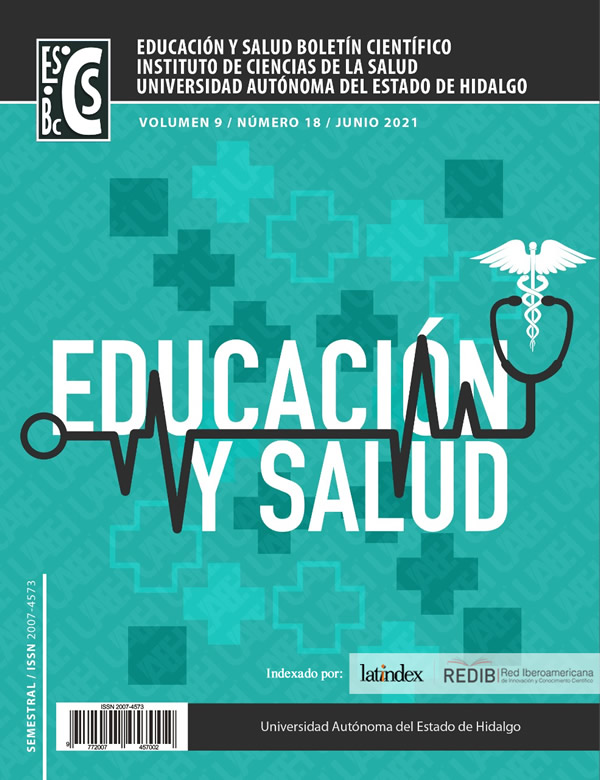Células madre de origen dental, una alternativa en tratamientos odontológicos
DOI:
https://doi.org/10.29057/icsa.v9i18.6582Palabras clave:
células madre, pulpa dental, regeneración tisular, diferenciación celular, implantesResumen
En los últimos años se han comprobado casos exitosos de tratamientos de enfermedades y regeneración de tejidos gracias a las células madre; sin embargo, se tiene la creencia de que dichas células, sólo se encuentran en el cordón umbilical o médula ósea.
Actualmente el uso de células madre en procedimientos odontológicos han demostrado ser de utilidad al mejorar y acelerar de manera eficaz los proceso de biointegración en procedimientos quirúrgico-dentales como: colocación de dispositivos intra óseos (implantes dentales), auto implantes, cirugías periodontales entre otros.
El descubrimiento de células madre en la pulpa dentaria ha llevado a realizar investigación sobre sus usos potenciales. Aunque aún no se conoce completo el rango de posibilidades de las células madre derivadas de los dientes, algunos investigadores creen que algún día, éstas podrían ser valiosas en la regeneración de los tejidos dentales y, posiblemente, de otros tejidos también.
Descargas
Información de Publicación
Perfiles de revisores N/D
Declaraciones del autor
Indexado en
- Sociedad académica
- N/D
Citas
Valencia-Hitte R, Espinosa-Fernández R, Saadia M, Velasco NJ, Nario H. Panorama actual de las células madre de la pulpa de dientes primarios y permanentes. RODYB. 2013; 2 (2): 1-33
Sai S. Effect on allogenic mesenchymal stem cells on osseointegration of dental implants. ClinicalTrials.gov. A service of the U.S. National Institutes of Health. 2016.
Schofield R. The relationship between the spleen colony-forming cell and the haemopoietic stem cell. Blood Cells. 1978;4(1-2):7-25
Hu J, Cao Y, Xie Y, Wang H, Fan Z, Wang J et al. Periodontal regeneration in swine after cell injection and cell sheet transplantation of human dental pulp stem cells following good manufacturing practice. Stem Cell Res Ther. 2016; 7 (1): 130.
Guo, W.; Chen, L.; Gong, K.; Ding, B.; Duan, Y. & Jin, Y. Heterogeneous Dental Follicle Cells and the Regeneration of Complex Periodontal Tissues. Tissue Eng. Part A., 18(5-6):459-70, 2012.
Uccelli A, Moretta L, Pistoia V. Mesenchymal stem cells in health and disease. Nat Rev Immunol. 2008;8(9):726–36.
Meirelles Lda S, Fontes AM, Covas DT, Caplan AI. Mechanisms involved in the therapeutic properties of mesenchymal stem cells. Cytokine Growth Factor Rev. 2009. Oct-Dec;20(5-6):419-27. doi: 10.1016/j.cytogfr.2009.10.002.
Shi Y, Hu G, Su J, Li W, Chen Q, Shou P, et al. Mesenchymal stem cells: a new strategy for immunosuppression and tissue repair. Cell Res. 2010 May;20(5):510-8
Ma S, Xie N, Li W, Yuan B, Shi Y, Wang Y. Immunobiology of mesenchymal stem cells. Cell Death Differ. 2014 Feb;21(2):216-25. doi: 10.1038/cdd.2013.158
Kim S, Shin SJ, Song Y, Kim E. In vivo experiments with dental pulp stem cells for pulp-dentin complex regeneration. Mediators Inflamm. 2015; 2015: 409347
Huang GTJ, Gronthos S, Shi S. Mesenchymal Stem Cells derived form dental tissues vs. those from othersources: their biology and role in Regenerative Medicine J Dent Res 2009; 88(9):792-806.
Franco D. Use of mesenchymal stem cells for alveolar bone tissue engineering for cleft lip and palate patients. ClinicalTrials.gov. A service of the U.S. National Institutes of Health. 2013.
Hargreaves K, Geisler T, Henry M, Wang Y. Regeneration potential of the young permanent tooth: what does the future hold? JOE 2008 July (7S); 34: S51-S56.
Lin NH, Menicanin D, Mrozik K, Gronthos S, Bartold PM. Putative stem cells in regenerating human periodontium. J Periodont Res 2008; 43: 514-523
. Kohji-Nagano R, Yoshida Y, Isobe T. Cell surface biomarkers of embryonic stem cells. Proteomics 2008; 8: 4025–4035.
Firriolo J, Rhodus N. Advances in hematologic stem cell transplant: An update for oral health care providers medical management and pharmacology update. Rhodus. 2009 March (3); 107: 301-312.
Friedlander LT, Cullinan MP, Love RM. Dental stem cells and their potential role in apexogenesis and apexi fication. Int Endod J 2009; 42:955-62.
Samiei M, Aghazadeh M, Movassaghpour A, Fallah A, Aminabadi N, et al. Isolation and Characterization of Dental Pulp Stem Cells from Primary and Permanent Teeth. Journal of American Science 2013; 9(12): 153-157.
Yang X, van der Kraan PM, Bian Z, Fan M, Walboo mers XF, Jansen JA. Mineralized Tissue Formation By BMP2-transfected Pulp Stem Cells. J Dent Res 2009; m88(11):1020-5.
D’Aquino R, Papaccio G, Laino G, Graziano A. Dental Pulp Stem Cells: A Promising Tool For Bone Regenera tion. Stem Cell Rev. 2008; 4:21-26.
Gandía C, Armiñán A, García-Verdugo JM, Lledó E, Ruiz A, Miñana MD et al. Human Dental Pulp Stem Cells Improve Left Ventricular Function, Induce Angiogenesis, and Reduce Infarct Size in Rats with Acute Myocardial Infarction. 2008; 26:638-645.
Karaöz E, Nur Dofan B, Aksoy A, Gacar G, Akyüz S, Ayhan S et al. Isolation and in Vitro characterisation of dental pulp stem cells from natal teeth. Histochem Cell Biol. 2010; 133:95-112.
Hu J, Cao Y, Xie Y, Wang H, Fan Z, Wang J et al. Periodontal regeneration in swine after cell injection and cell sheet transplantation of human dental pulp stem cells following good manufacturing practice. Stem Cell Res Ther. 2016; 7 (1): 130.
Gong T, Heng BC, Lo EC, Zhang C. Current advance and future prospects of tissue engineering approach to dentin/pulp regenerative therapy. Stem Cells Int. 2016; 2016: 9204574.
Romero-Jasso G, Aldape-Barrio B. Bioingeniería dental, ¿El futuro de la terapia en odontología? Rev ADM. 2011; 68 (4): 169-174..
Tatullo M, Marrelli M, Shakesheff KM, White LJ. Dental pulp stem cells: function, isolation and applications in regenerative medicine. J Tissue Eng Regen Med. 2015; 9 (11): 1205-1216
Gotlieb EL, Murray PE, Namerow KN, Kuttler S, García-Godoy F. An Ultrastructural Investigation Of Tissue- Engineered Pulp Constructs Implanted Within En dodontically Treated Teeth. J Am Dent Assoc. 2008; 139:457-465



















